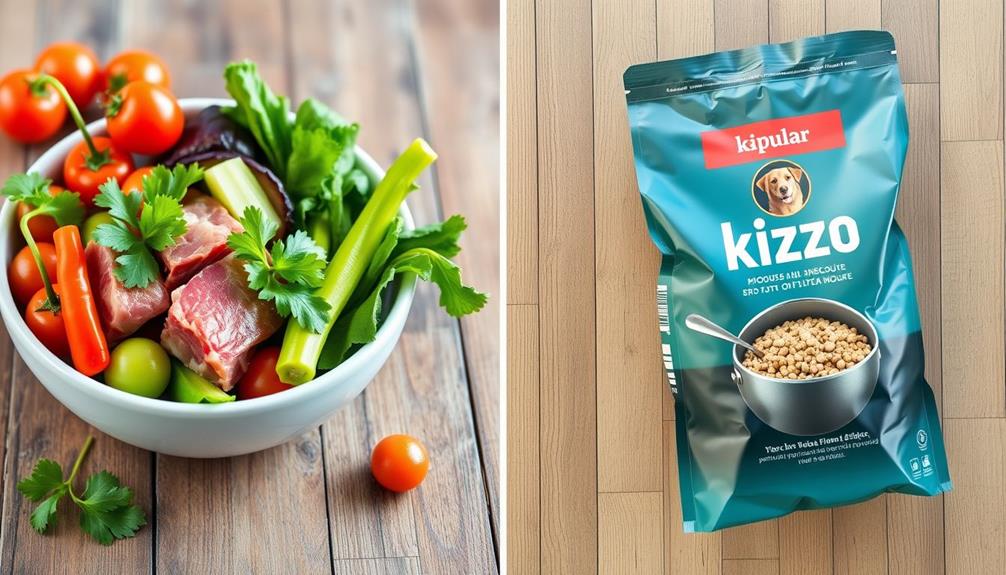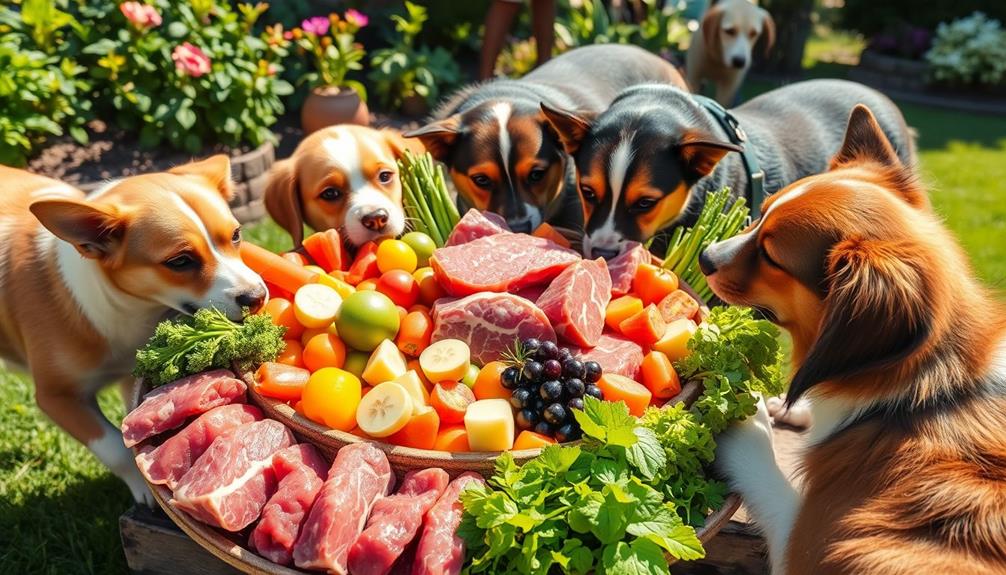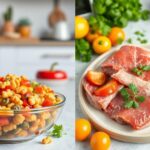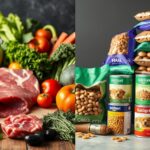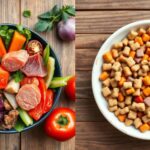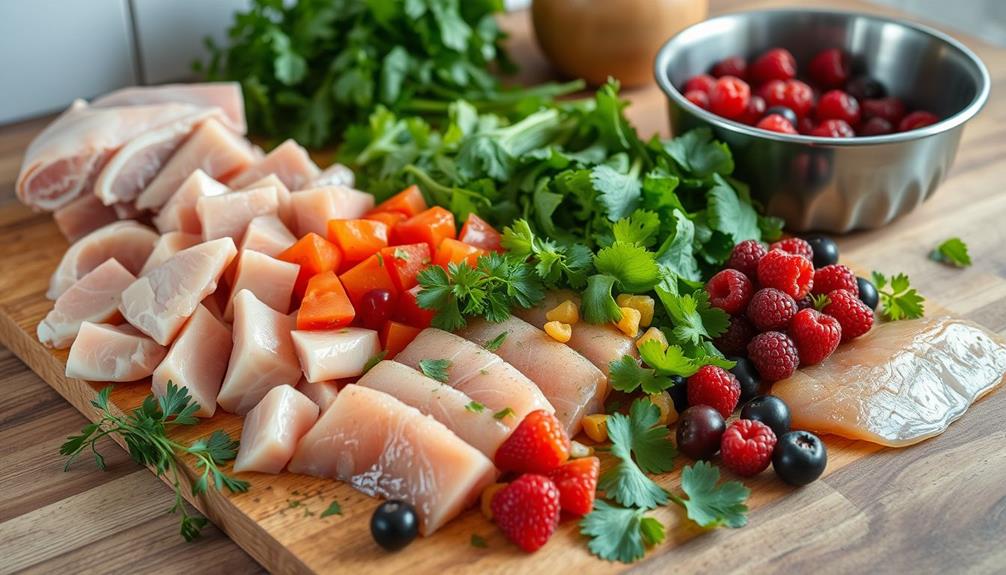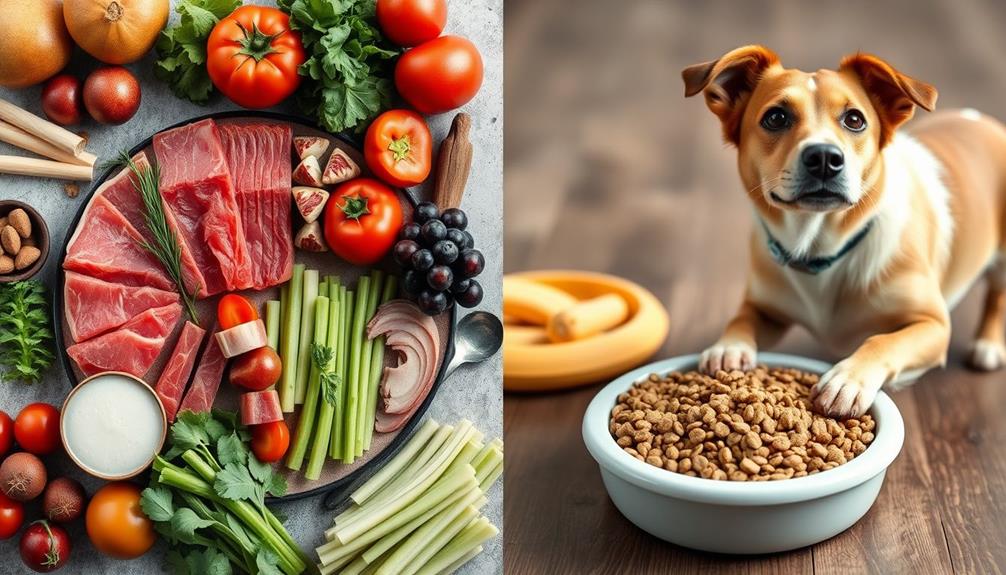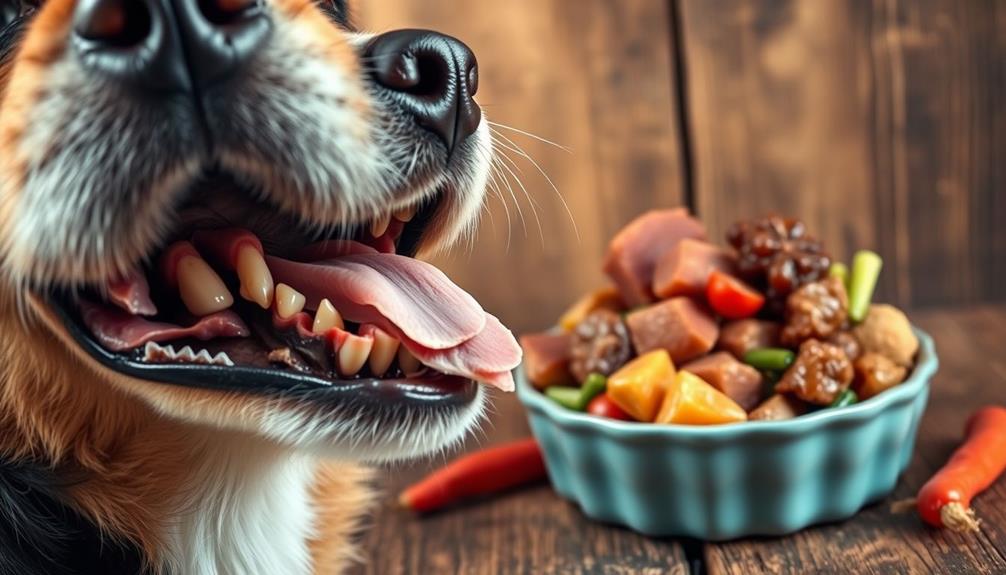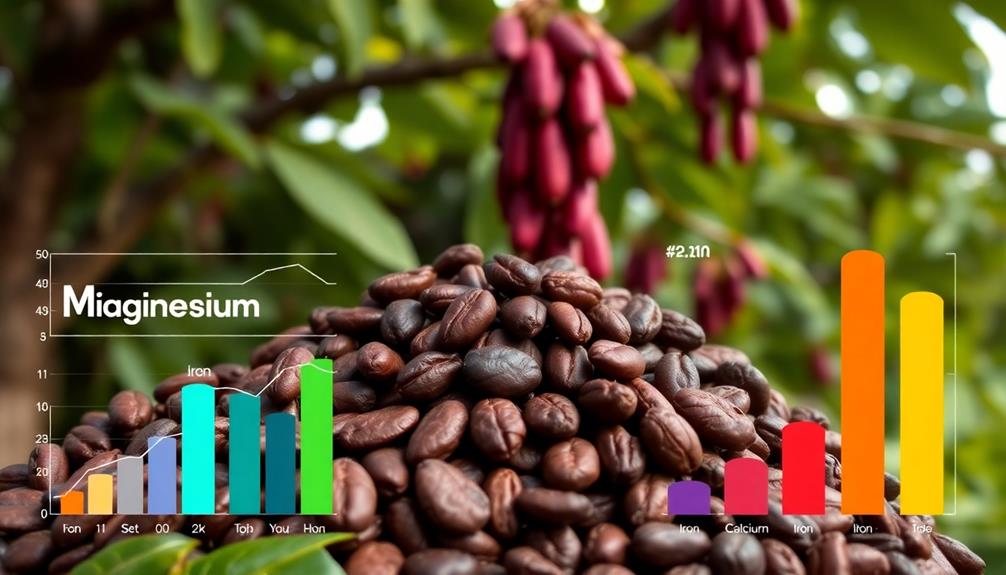Choosing between raw food and kibble for your dog comes down to nutrition and convenience. Raw diets offer higher digestibility and better nutrient absorption, while kibble is practical and cost-effective. Raw food promotes healthier coats and improved digestion, but it requires preparation and refrigeration. Kibble, on the other hand, is convenient, has a long shelf life, and meets strict nutritional standards. Each diet has its benefits, but you need to evaluate your dog's specific needs. The right choice often depends on your lifestyle and your pup's health, and there's more to discover about optimizing their diet. If you’re torn between raw food and kibble, you might consider mixing the two. This combination can provide the benefits of both diets, offering convenience and variety in your dog’s meals. However, it’s essential to research and consult with a veterinarian to ensure that you’re meeting all of your dog’s nutritional needs when mixing kibble and raw food.
Key Takeaways
- Raw food diets enhance nutrient absorption and digestion, leading to improved overall health compared to kibble.
- Kibble is more convenient and cost-effective, with a longer shelf life and no refrigeration needed.
- Raw diets typically contain fewer carbohydrates and artificial additives, promoting better digestive health and reducing gastrointestinal issues.
- Dogs on raw food diets often exhibit shinier coats and fewer skin irritations due to high-quality ingredients and essential fatty acids.
- Balanced raw diets require careful formulation and veterinary guidance to avoid nutritional deficiencies, unlike standard kibble which meets established nutritional standards.
Overview of Dog Diets
When it comes to choosing the best diet for your dog, what options do you have? You'll find various dog diets available, including kibble, raw food diets, wet, and fresh food options. Each of these diets has distinct ingredients and nutritional profiles that can affect your dog's health.
Additionally, understanding the potential side effects and interactions of certain ingredients can be essential for your dog's well-being, particularly if your pet has existing health issues or is on medication common types of cold medications.
Kibble, a popular choice, is a dry, commercially available food. It often contains high carbohydrate levels, ranging from 40% to 60%, sourced from grains like rice and corn. While convenient, low-quality kibbles may include fillers and byproducts that don't provide ideal nutrition.
On the other hand, raw food diets consist of uncooked meat, bones, and dog-safe fruits and vegetables, usually maintaining lower carbohydrate levels, often less than 10%.
The nutritional quality between these diets varies considerably. Raw diets generally feature high-quality, minimally processed ingredients, which could lead to better nutrient absorption. This might enhance your dog's overall health and digestion.
Understanding these differences is essential as you consider which dog diet aligns best with your pet's specific needs and lifestyle.
Benefits of Raw Food
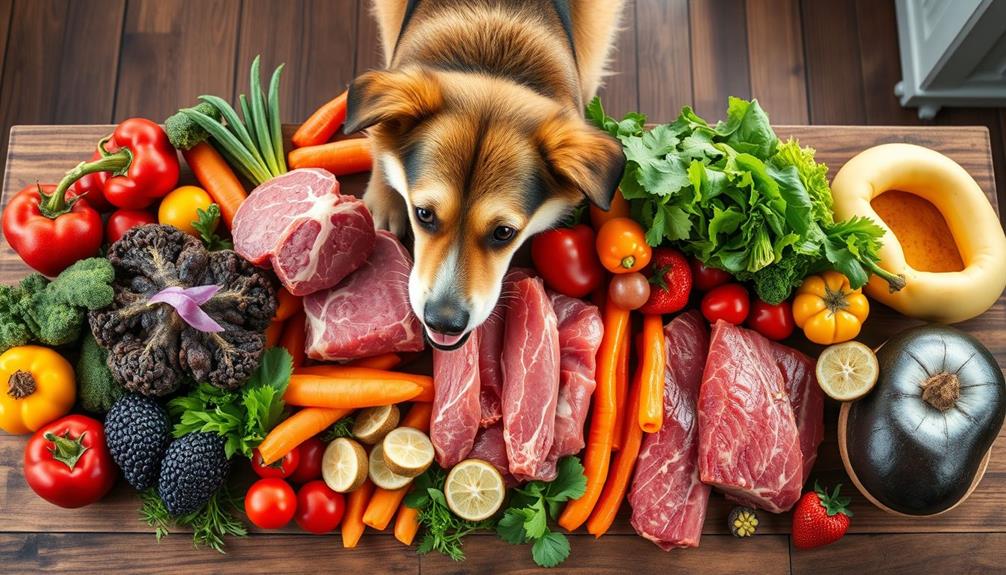
When you switch your dog to a raw food diet, you might notice a significant boost in nutrient absorption efficiency.
This can lead to improved digestive health and a shinier coat, making your pup look and feel their best.
Additionally, incorporating natural ingredients in their diet can promote overall health and wellness.
Plus, with better overall health, you could save on vet bills in the long run.
Nutrient Absorption Efficiency
Raw food diets greatly enhance nutrient absorption efficiency, benefiting your dog's overall health. Unlike kibble, which undergoes high-heat processing that can destroy essential vitamins and enzymes, raw diets maintain their nutritional integrity.
Additionally, proper diet and care for pets, including dogs, emphasize the importance of understanding their natural dietary needs and preferences, as seen in ultimate pet care guidelines.
Here are some key points to examine:
- Higher Nutrient Absorption: Dogs on raw meat-based diets (RMBDs) can absorb 70-80% of the nutrients, compared to considerably lower rates in kibble diets.
- Lower Carbohydrate Content: Raw diets often contain less than 10% carbohydrates, aligning better with a dog's natural dietary needs.
- Bioavailability: The bioavailability of nutrients in raw food is generally greater, allowing your dog to utilize nutrients more effectively.
- Balanced Nutrition: When properly balanced, raw food diets provide species-appropriate nutrition, reducing the risk of nutritional deficiencies often found in kibble diets.
Improved Digestive Health
Improved digestive health is one of the standout benefits of switching to a raw food diet for dogs. When you feed your dog a raw diet, you're providing a meal that's more easily digestible compared to kibble. Kibble often contains fillers and high carbohydrate content that can hinder your dog's digestive efficiency, leading to issues like gas and diarrhea.
Additionally, raw diets typically contain fewer artificial preservatives and fillers, which can further support digestive health and reduce gastrointestinal discomfort. Studies show that dogs on raw meat-based diets (RMBDs) have better gastrointestinal health, reflected in higher levels of fecal immunoglobulin A and G, which are crucial for immune function. RMBDs typically contain less than 1% starch, making them more aligned with a dog's natural dietary needs, while many kibbles can have up to one-third starch.
Additionally, raw diets allow for better nutrient absorption due to the bioavailability of nutrients in minimally processed ingredients. In contrast, the high-heat processing of kibble can destroy essential nutrients and digestive enzymes.
Many raw dog advocates report fewer digestive issues, emphasizing that the absence of artificial preservatives and fillers in raw food contributes to improved digestive health for their furry friends. For instance, the benefits of fresh ingredients are highlighted in studies on cranberry juice consumption.
Enhanced Coat Condition
Switching to a raw food diet not only enhances your dog's digestive health but also greatly benefits their coat condition. When you feed your dog a raw meat-based diet (RMBD), you can expect noticeable improvements in their fur and skin.
Essential oils like eucalyptus oil can also be beneficial for overall health, contributing to a shiny coat and reducing skin irritations. Here are some key benefits:
- Shinier Fur: The essential fatty acids found in raw diets contribute to a glossy, healthy coat.
- Reduced Shedding: Many dog owners report less shedding due to the elimination of low-quality ingredients common in kibble.
- Fewer Skin Irritations: By avoiding fillers and artificial additives, raw food helps minimize skin issues.
- Better Nutrient Absorption: Raw diets allow for increased bioavailability of nutrients, promoting overall coat health.
Incorporating organ meats along with dog-safe fruits and vegetables adds a diverse nutrient profile that supports vibrant fur.
Studies suggest that dogs on RMBDs often experience lower inflammation levels, which directly contributes to healthier skin and fur.
Making the switch to raw can lead to a significant transformation in your dog's coat condition, ensuring they not only look good but feel good too!
Advantages of Kibble

When you choose kibble, you're opting for a cost-effective feeding option that can fit any budget.
Many brands comply with USDA nutritional standards, ensuring your dog gets the essential nutrients they need.
Additionally, kibble can be a part of a balanced budget plan for pet owners looking to manage their finances effectively.
Plus, the convenience of kibble means you won't have to worry about refrigeration or complicated meal prep.
Nutritional Standards Compliance
Kibble offers a reliable choice for dog owners seeking compliance with nutritional standards. When you choose kibble, you can rest assured that it meets essential guidelines.
Additionally, just like diversifying retirement portfolios with Gold IRAs, selecting the right kibble provides a well-rounded approach to your dog's nutrition. Here are some key advantages:
- Regulatory Compliance: Kibble must adhere to strict nutritional needs set by the USDA, ensuring quality and safety.
- Balanced Nutrition: Most commercial dog food formulations include a mix of protein sources, grains, vitamins, and preservatives to provide a complete diet.
- AAFCO Standards: Many kibble brands undergo rigorous testing to confirm they meet the Association of American Feed Control Officials (AAFCO) standards, guaranteeing nutritional adequacy.
- Energy Support: Kibble typically contains 40-60% carbohydrates, designed to provide energy for your dog's activity levels while being easy to store.
Cost-Effective Feeding Option
For pet owners on a budget, choosing kibble can be a smart and cost-effective feeding option. Kibble generally costs between $1 and $13 daily, while raw diets can range from $3 to over $10 daily. This budget-friendly choice allows you to provide balanced nutrition without breaking the bank.
Additionally, kibble's long shelf life and ease of storage eliminate the need for refrigeration and complicated meal prep. It also helps reduce dental plaque and tartar build-up, promoting better oral health for your dog. Many kibble brands meet USDA nutritional standards, ensuring your dog gets all essential nutrients without extra supplements.
Here's a quick comparison of kibble versus raw food:
| Aspect | Kibble | Raw Food |
|---|---|---|
| Daily Cost | $1 – $13 | $3 – $10+ |
| Storage | Easy, no fridge | Requires fridge |
| Preparation Time | Quick | Time-consuming |
| Nutritional Quality | Meets standards | Varies |
| Dental Health Benefits | Yes | No |
Nutritional Comparison
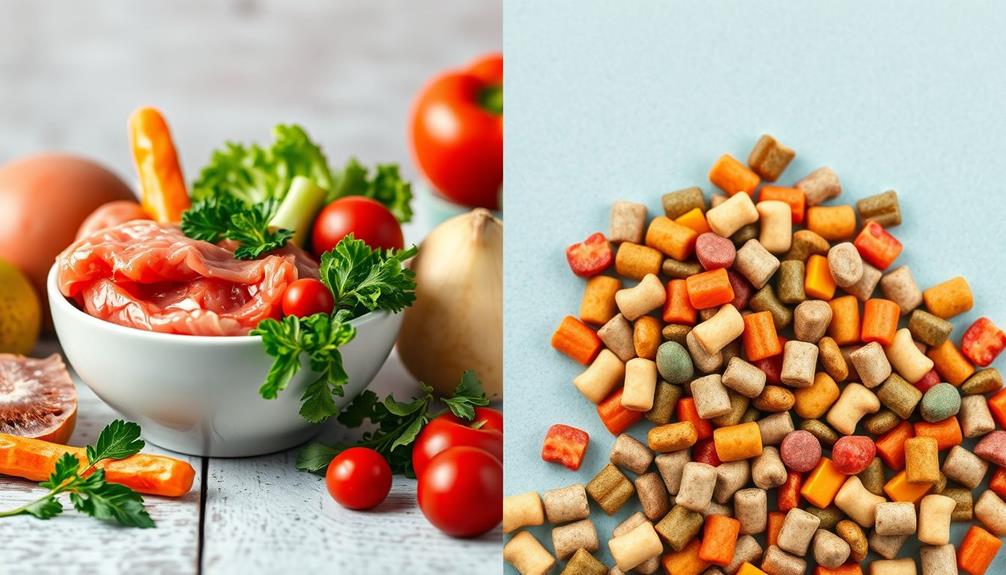
The nutritional comparison between raw food and kibble is essential for any dog owner seeking the best diet for their furry friend. When considering raw diets versus kibble, here are some key points to keep in mind:
1. Digestibility: Raw dog food offers higher digestibility, allowing better absorption of essential vitamins, minerals, and amino acids compared to kibble, which often loses nutrients during processing.
Additionally, many pet owners are discovering the benefits of high-quality ingredients in raw diets that contribute to improved health outcomes.
2. Carbohydrate Content: Kibble diets contain 40-60% carbohydrates from high-starch sources, while raw diets maintain carb levels below 10%, focusing on more biologically appropriate proteins and fats.
3. Ingredient Quality: Many low-quality kibbles use plant-based proteins and fillers that dilute nutritional value. In contrast, raw diets prioritize high-quality, minimally processed ingredients.
4. Health Indicators: Research shows dogs on raw meat-based diets (RMBD) had lower alkaline phosphatase levels and improved immune markers, hinting at better overall health compared to those eating kibble.
Understanding these differences can help you make an informed decision about your dog's diet. The nutritional value of what you feed your furry friend can greatly impact their health and well-being.
Health Implications
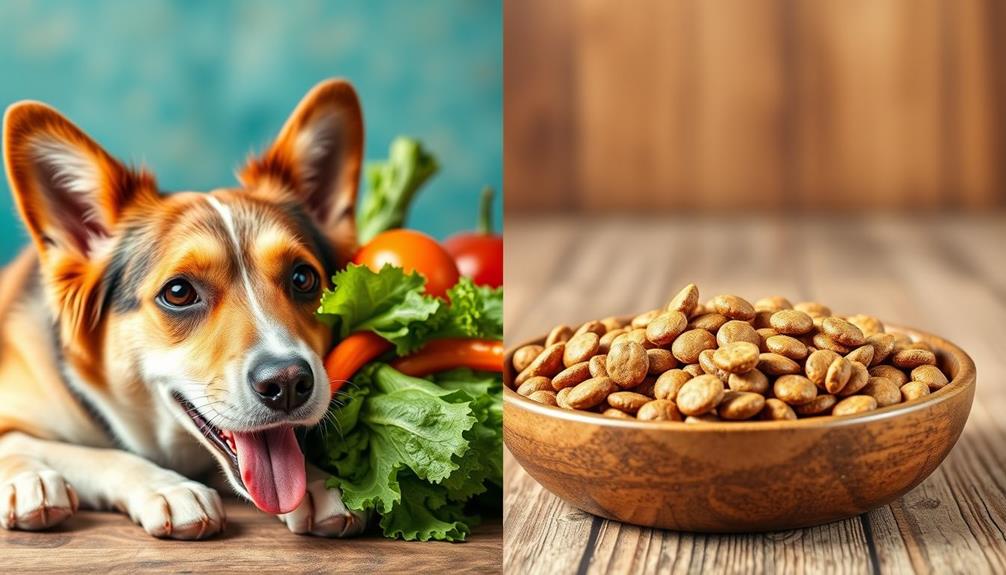
Considering the nutritional differences between raw food and kibble, health implications arise that can significantly affect your dog's well-being. Research shows that dogs on raw meat-based diets (RMBD) exhibit lower alkaline phosphatase levels and improved lymphocyte counts compared to those on kibble diets. This suggests that RMBD can lead to better overall health markers.
Additionally, adopting a balanced diet is essential for overall health; thus, ensuring that RMBDs are well-formulated is vital. Incorporating effective strategies for weight loss can also be beneficial, as maintaining a healthy weight is fundamental for a dog's longevity.
Moreover, dogs consuming RMBD often display a greater albumin:globulin ratio, which indicates an enhanced protein status and potentially improved immune function. In contrast, kibble diets, typically high in carbohydrates, have been associated with obesity and cardiovascular issues. RMBDs promote better digestion and nutrient absorption, further supporting your dog's health.
Additionally, RMBDs may enhance gastrointestinal homeostasis and immune function, with studies showing higher levels of fecal IgA and IgG in dogs fed a raw diet.
However, it's significant to mention that over 90% of dogs on RMBDs have reported nutritional deficiencies, underscoring the necessity of balanced nutrition for maintaining canine health. Ultimately, choosing between RMBD and kibble diets involves weighing these health implications carefully.
Cost Analysis
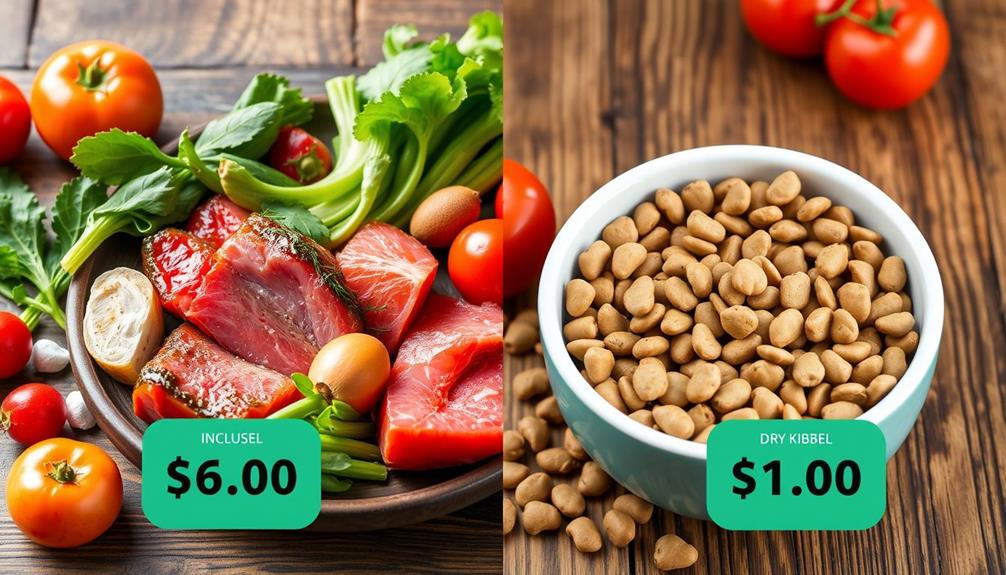
When evaluating the cost of dog food options, it's important to compare the financial implications of raw food diets versus kibble. Here's a quick cost analysis to reflect on:
- Daily Costs: Kibble typically ranges from $1 to $13 daily, while raw food can cost between $3 to $10+ daily. The long-term benefits of investing in a better diet can be significant, as regular market analysis for informed investment decisions can apply to pet health as well.
- Long-Term Savings: Although raw food is more expensive upfront, it may reduce long-term veterinary expenses linked to kibble-related health issues.
- Dog Preference: Many dogs prefer raw food over kibble, which can enhance their eating experience and lead to better overall health.
- Hybrid Diets: Mixing kibble and raw food allows for a gradual shift, meeting your dog's nutritional needs while optimizing cost.
Investing in raw food can align with your growing health consciousness, as the benefits of balanced, species-specific diets often justify the higher costs.
While raw diets may seem pricier initially, their potential to improve your dog's health and reduce future vet bills can make them a worthwhile investment in the long run.
Weigh these factors carefully as you decide what's best for your furry friend.
Expert Recommendations
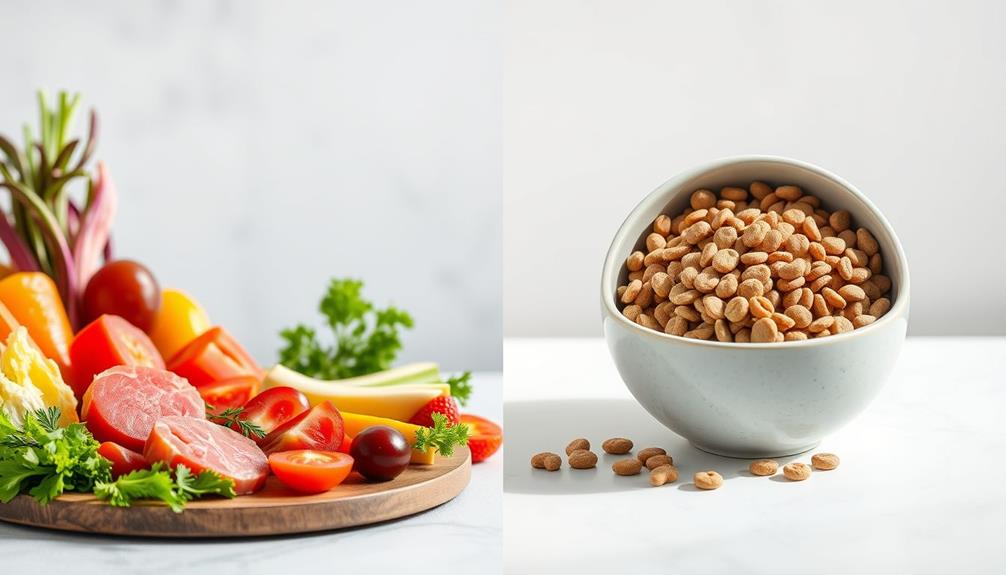
How can you guarantee your dog benefits from a raw diet while minimizing potential risks?
Veterinary nutritionists recommend a balanced approach to feeding, emphasizing that while raw diets can offer high-quality nutrients, they must be carefully formulated to avoid nutritional imbalances.
It's essential to consult with a veterinarian experienced in raw diets before making any changes. They can guide you on proper handling and sanitation practices, reducing the risk of bacterial contamination, especially if you have children or immunocompromised individuals in your household.
Experts agree that shifting your dog to a raw diet should be gradual.
Start by monitoring your dog's health and digestive response closely. Introduce a variety of raw protein sources to create a well-rounded nutrient profile.
Research shows that raw meat-based diets may enhance immune function and gastrointestinal health, showing significant improvements in inflammatory markers compared to kibble diets.
Frequently Asked Questions
Is Raw Food Healthier for Dogs Than Kibble?
When considering whether raw food's healthier for dogs than kibble, you should evaluate factors like ingredient quality, nutrient absorption, and potential health benefits. Each dog's specific needs may influence the best choice for them.
Should I Feed My Dog Dry or Raw Food?
You might think raw food's too complicated, but it can be straightforward! If you're considering what to feed your dog, think about their health; raw diets often lead to better digestion and nutrient absorption.
What Is the Healthiest Food to Feed Your Dog?
To keep your dog healthy, focus on balanced nutrition. Choose high-quality proteins, healthy fats, and essential vitamins. Consult your vet for personalized advice, ensuring your dog gets what they need for peak health.
Do Vets Recommend a Raw Diet for Dogs?
Most vets don't recommend raw diets for dogs due to health risks, like bacterial contamination. They stress the importance of balanced nutrition and suggest consulting a veterinary nutritionist if you're considering alternative feeding options.
Conclusion
In the debate between raw food and kibble, it's clear that both options have their pros and cons. You'll want to contemplate your dog's specific needs, lifestyle, and any health concerns. While raw food can offer fresher nutrients, kibble provides convenience and long shelf life. Ultimately, it's about finding the right balance for your furry friend. Remember, you can't judge a book by its cover; what matters most is what works best for your dog's health and happiness.

